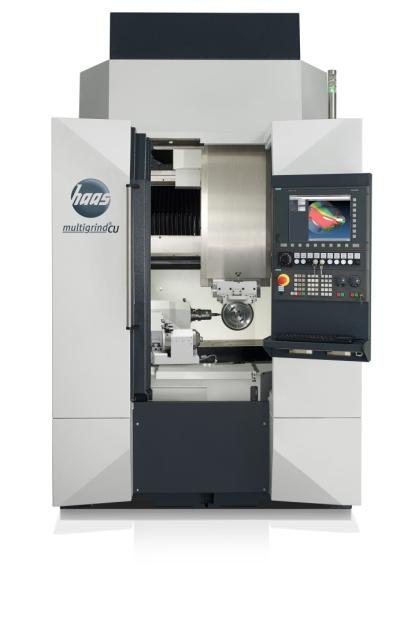
In grinding technology, the trend is toward full-sequence machining, especially for complex workpieces that need to be completed on versatile grinding machines. Combining multiple operations into one machine cycle saves on transport and warehousing cost. It also results in higher overall precision. High-quality milling tools, indexable inserts and step drills are all examples. Universal grinding machines required for producing tools like these are the trademarks of HAAS Schleifmaschinen GmbH in Trossingen at the edge of the Black Forest. The company supplies machines with customized configurations, including a detailed processing strategy with all the components required, from the programming, toolchanger and dressing units to fully automated, part-handling systems.
HAAS' latest development is the Multigrind CU, destined to replace the AF series due to its long list of productive features packed into a small footprint. It is the smallest machine in the HAAS product line.
While the largest machine in the HAAS series, Multigrind CB, can accommodate grinding wheels with diameters of up to 300 mm [12”] and process workpieces with diameters of 340 mm to 500 mm [20”], the medium-sized HAAS machine, Multigrind CA, was engineered for grinding wheels of up to 250 mm [10”] and workpieces of up to 260 mm [10.25”]. MultigrindCU accommodates wheels of up to 225 mm [9”] and workpieces of up to 180 mm [7”].
The new CU's width is 50 mm less than its predecessor, the AF machine. Because the coolant system and its two large tanks are integrated into the machine bed, the new model requires less than half the space of the old AF. The robot function was external to the machine in the past, but the HAAS developers have successfully integrated it into the CU. A masterful solution to customers' need for compactness and automation.
The operation, maintenance and servicing concept is just as sophisticated. There are no operator or service access points on the sides of the machine. Consequently, the CU machines can be “stacked” side-by-side to save significant floor space. The machine is loaded, unloaded and programmed at the front, and the back is reserved for maintenance. Despite its small space, the CU still has a toolchanger with nine to 14 positions, depending on the tool size. This means three times more capacity than its predecessor. The toolchanger is loaded at the front.
The compact design also required a new axis concept, so the developers came up with a special solution. "At HAAS, we don't use cheap, low quality components," said Thomas Bader, explaining the HAAS philosophy. "Rather, we develop intelligent concepts that allow us to save on axes by means of a multiple axis configuration without any negative impact on performance or functionality, for example."
The new machine's axis arrangement follows the classical gantry principle, in which the X, Y and Z axes are positioned at the top. The Y-axis runs along the side of the machine bed. Both the A-axis for rotating the workpiece and the machine table are attached to the C-axis. The C-axis also drives the circular tool magazine, which is installed under the table. The gripper, which can load the machine from four integrated pallets, is installed on the Z-axis so that it can travel in the X, Y and Z directions without the extra cost and floor space of a robot or any additional axes.
This makes the new Multigrind CU series as universally applicable as the two series of larger machines. Due to its size and capacity, it is especially suitable for manufacturing indexable inserts, inserts, drills and other metalworking tools. Other applications that require the high precision full-sequence machining of smaller workpieces with complex geometries in only one setting are also possible.
Related Glossary Terms
- coolant
coolant
Fluid that reduces temperature buildup at the tool/workpiece interface during machining. Normally takes the form of a liquid such as soluble or chemical mixtures (semisynthetic, synthetic) but can be pressurized air or other gas. Because of water’s ability to absorb great quantities of heat, it is widely used as a coolant and vehicle for various cutting compounds, with the water-to-compound ratio varying with the machining task. See cutting fluid; semisynthetic cutting fluid; soluble-oil cutting fluid; synthetic cutting fluid.
- dressing
dressing
Removal of undesirable materials from “loaded” grinding wheels using a single- or multi-point diamond or other tool. The process also exposes unused, sharp abrasive points. See loading; truing.
- gang cutting ( milling)
gang cutting ( milling)
Machining with several cutters mounted on a single arbor, generally for simultaneous cutting.
- grinding
grinding
Machining operation in which material is removed from the workpiece by a powered abrasive wheel, stone, belt, paste, sheet, compound, slurry, etc. Takes various forms: surface grinding (creates flat and/or squared surfaces); cylindrical grinding (for external cylindrical and tapered shapes, fillets, undercuts, etc.); centerless grinding; chamfering; thread and form grinding; tool and cutter grinding; offhand grinding; lapping and polishing (grinding with extremely fine grits to create ultrasmooth surfaces); honing; and disc grinding.
- metalworking
metalworking
Any manufacturing process in which metal is processed or machined such that the workpiece is given a new shape. Broadly defined, the term includes processes such as design and layout, heat-treating, material handling and inspection.
- milling
milling
Machining operation in which metal or other material is removed by applying power to a rotating cutter. In vertical milling, the cutting tool is mounted vertically on the spindle. In horizontal milling, the cutting tool is mounted horizontally, either directly on the spindle or on an arbor. Horizontal milling is further broken down into conventional milling, where the cutter rotates opposite the direction of feed, or “up” into the workpiece; and climb milling, where the cutter rotates in the direction of feed, or “down” into the workpiece. Milling operations include plane or surface milling, endmilling, facemilling, angle milling, form milling and profiling.
- toolchanger
toolchanger
Carriage or drum attached to a machining center that holds tools until needed; when a tool is needed, the toolchanger inserts the tool into the machine spindle. See automatic toolchanger.






